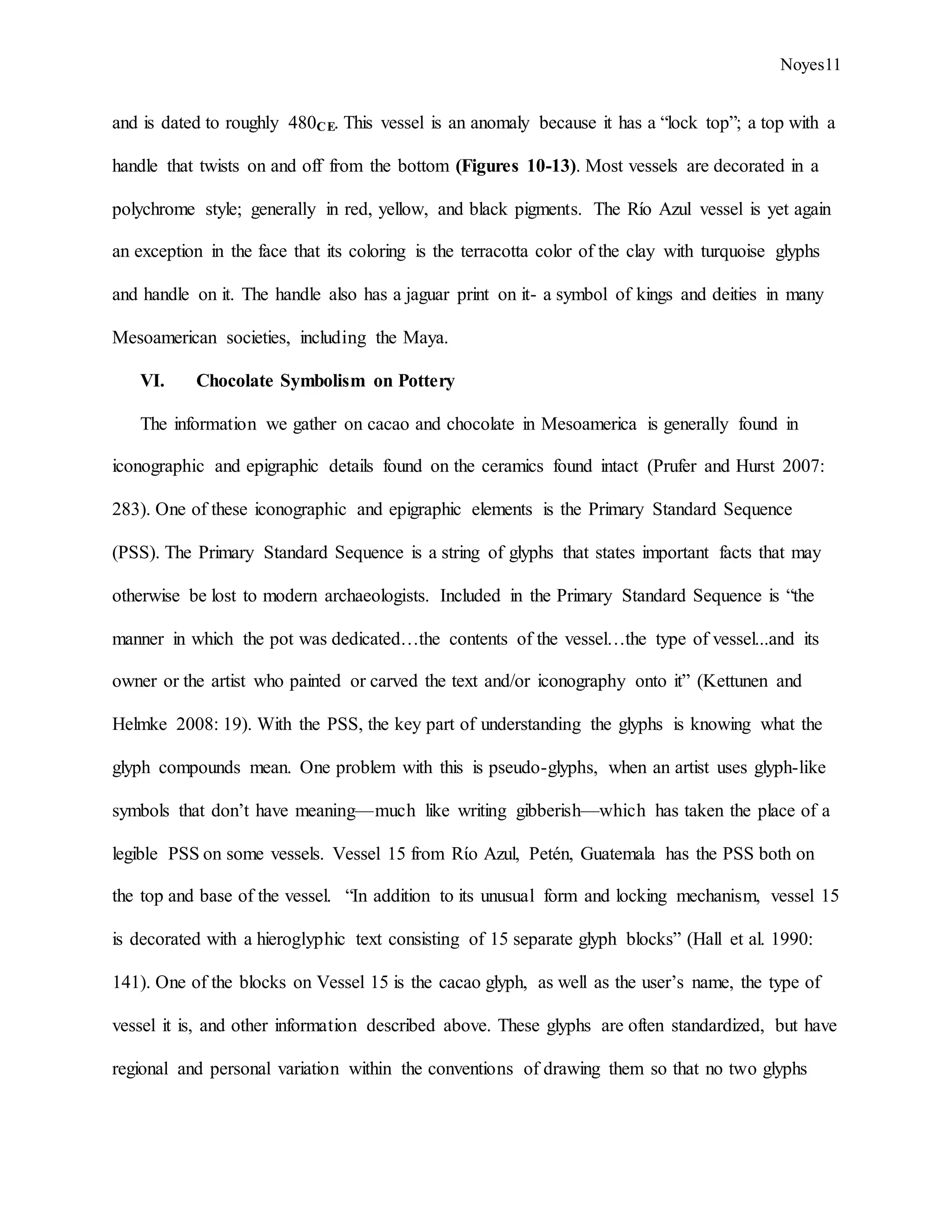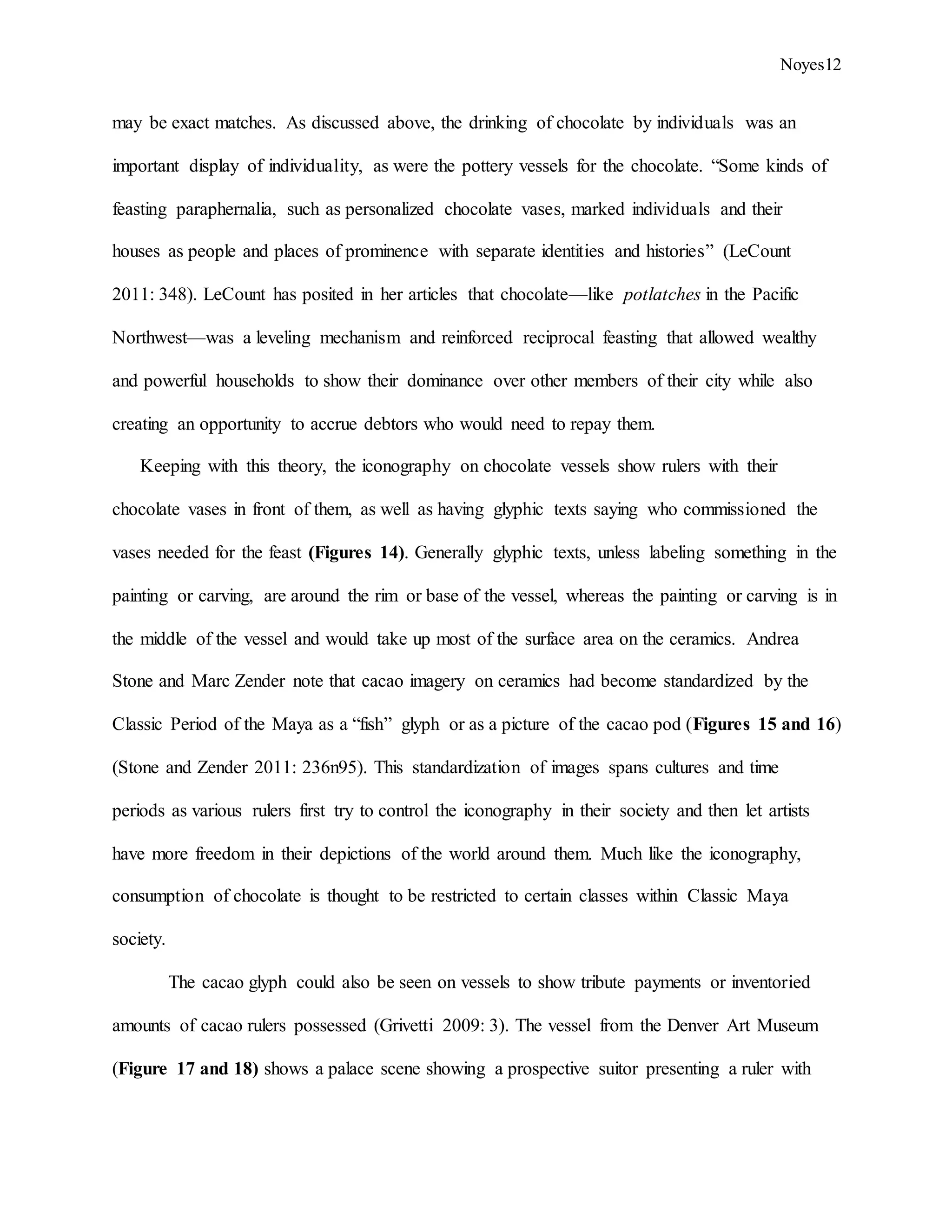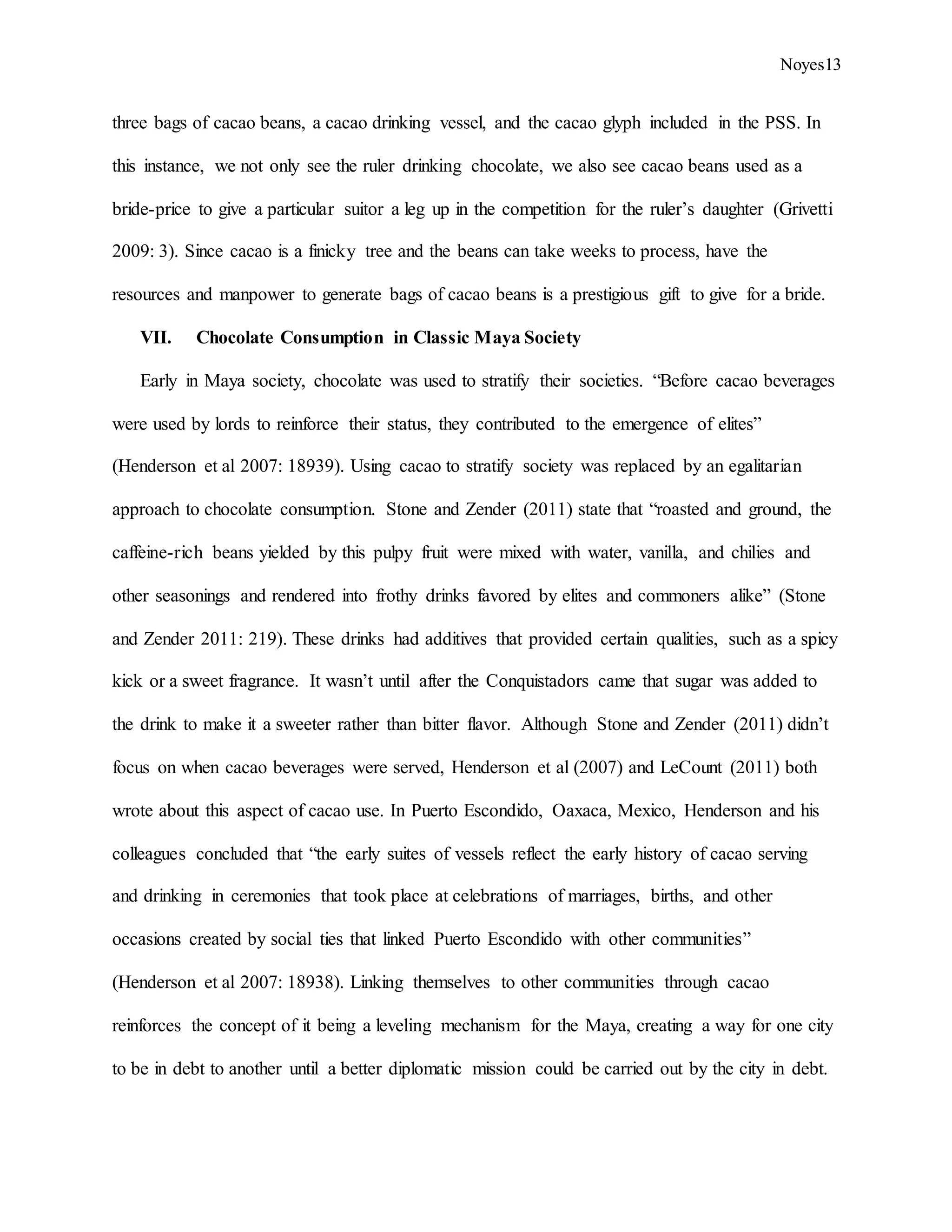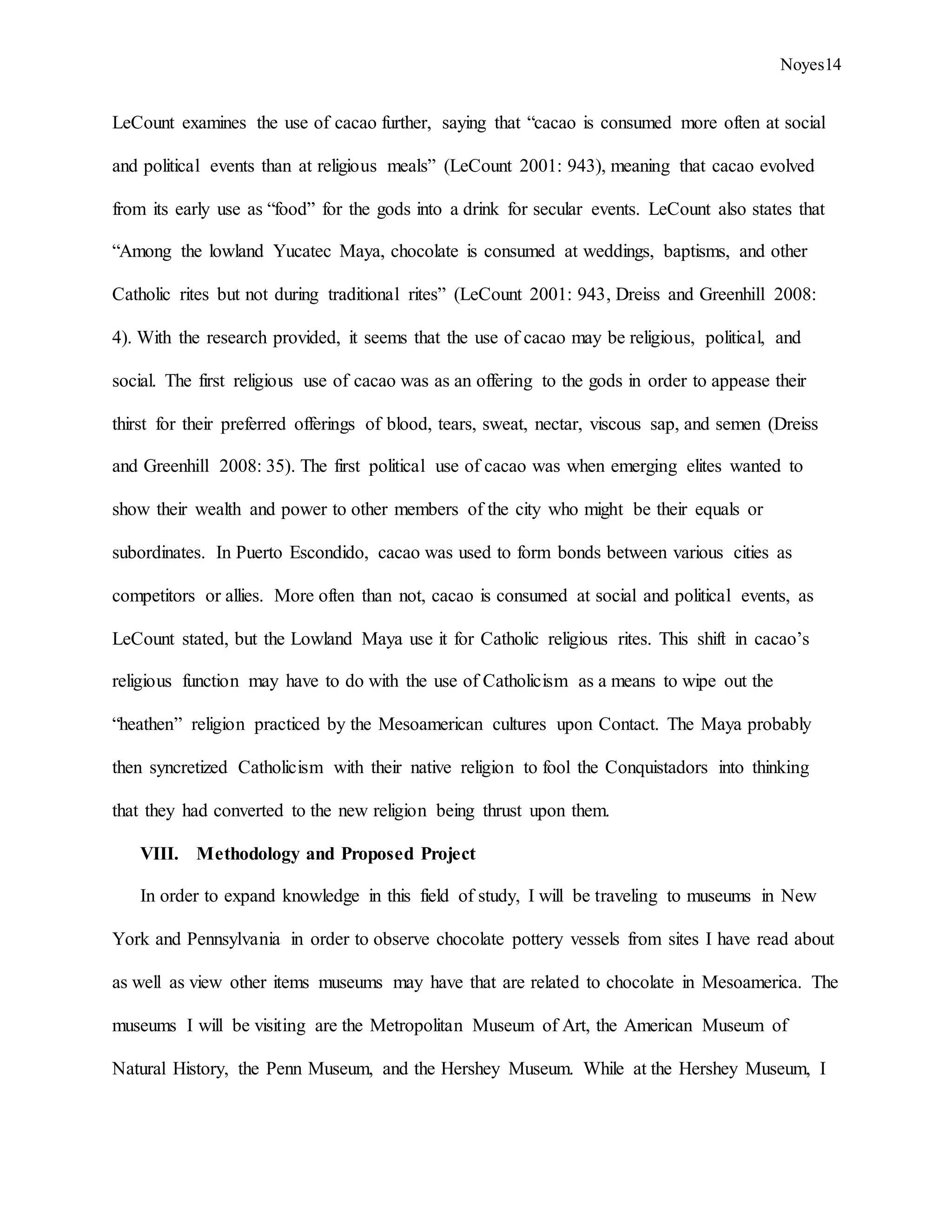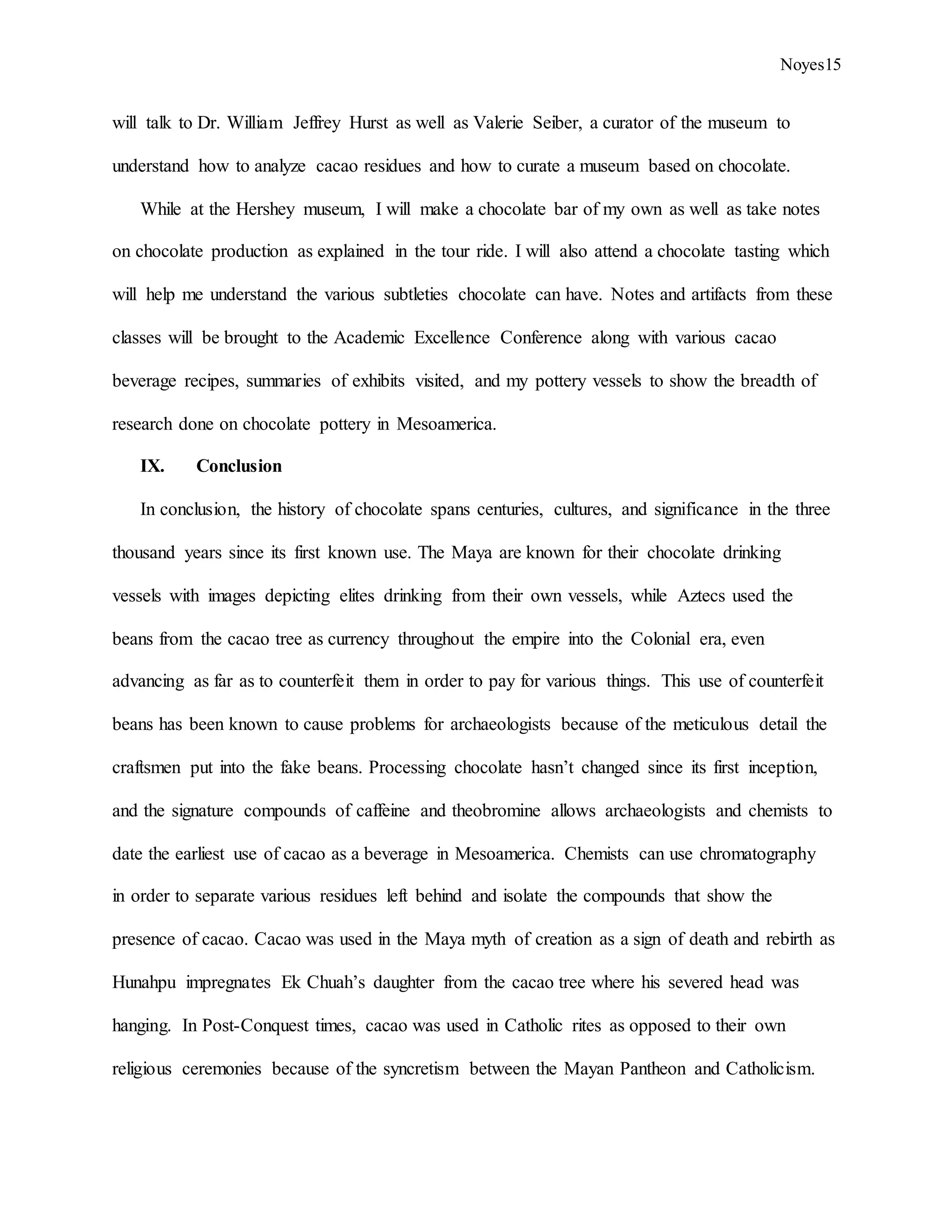The document summarizes the history and use of chocolate among the Maya civilization. It discusses how the Maya inhabited parts of Central America from 1000 BCE to 1521 CE and had a complex society that rivaled Europe during 250-900 CE. It describes how the Spanish conquistadors encountered and recorded Maya society in the early 1500s CE, though some original Maya documents were destroyed. It then discusses the long history of chocolate use in Mesoamerica dating back to 1900 BCE, its role in Maya culture and religion as depicted in texts like the Popol Vuh, and how it was introduced to Europe and became popular after the addition of sugar.
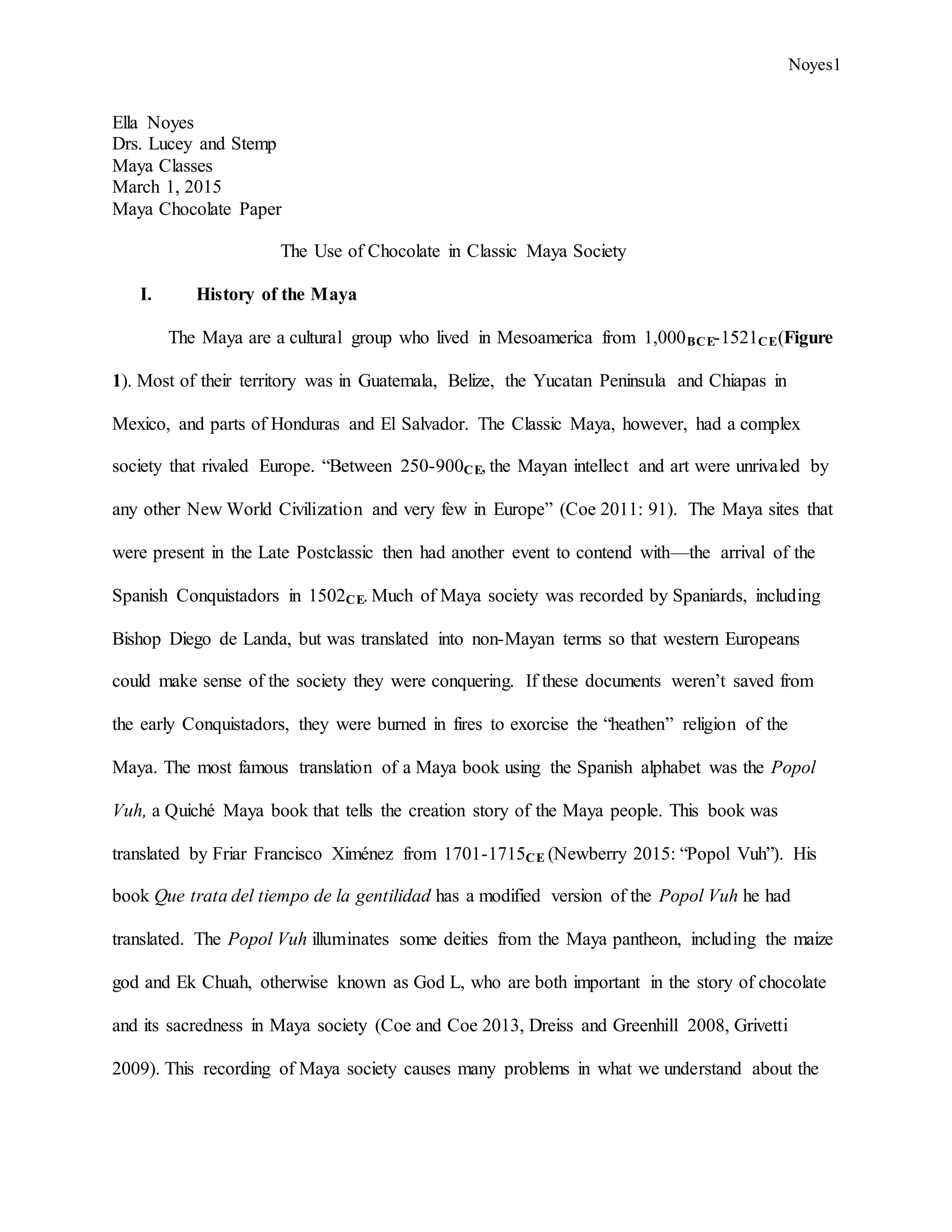

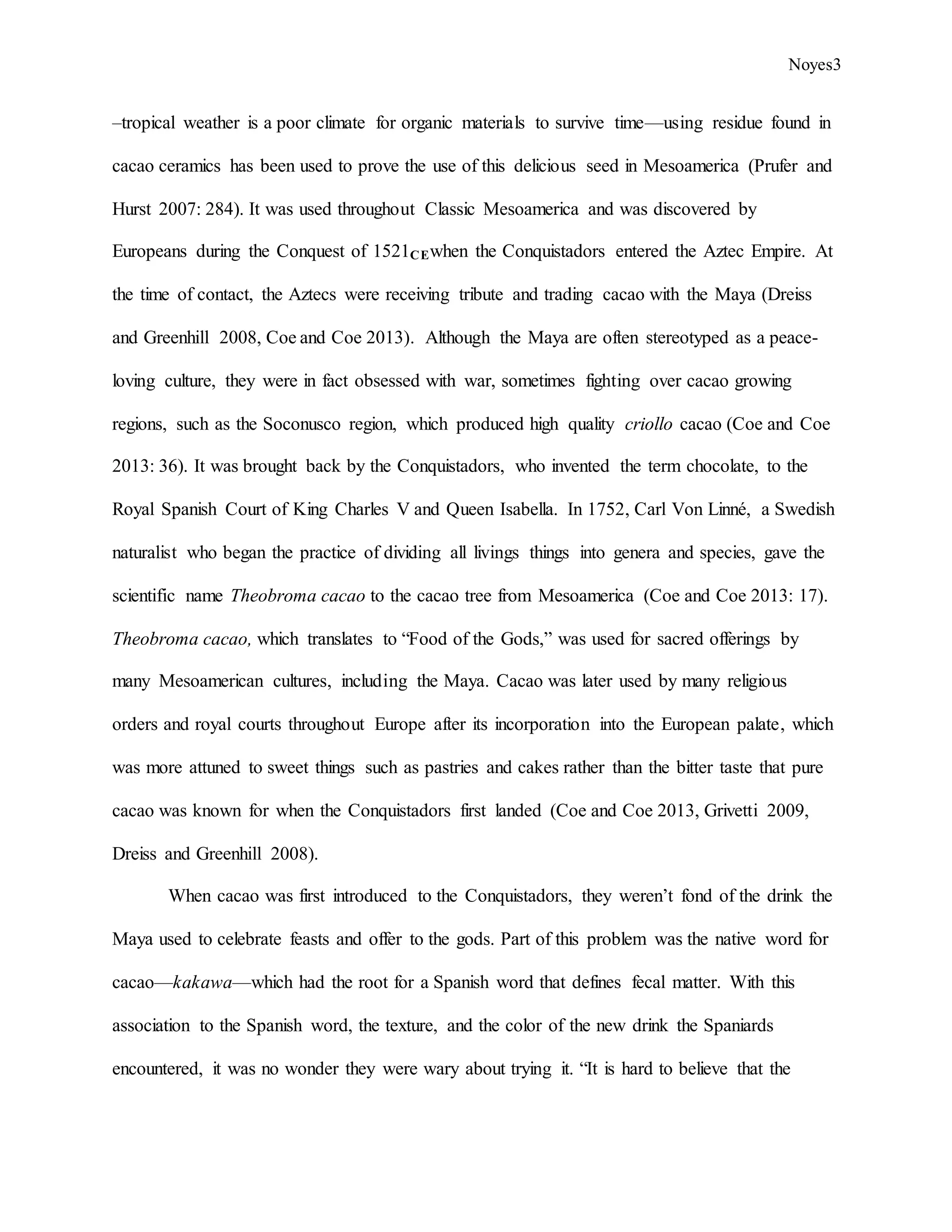
![Noyes4
Spaniards were not thoroughly uncomfortable with a noun beginning with caca to describe a
thick, dark-brown drink which they had begun to appreciate” (Coe and Coe 2013: 119). This
linguistic barrier was overcome by using the word chocolate, which was first implemented by the
Conquistadors. After the use of additive sugar became widespread among the Spaniards, they
brought it back to the Royal court as a sweet, not bitter, drink that was found in “New Spain.”
With its introduction into “high” society, cacao was also written about as being a medicine, not
just a pleasant drink. “The cacao seed is ‘temperate in nature,’ he [Hernández] says, but leaning
to the ‘cold and humid’; on the whole, it is very nourishing. Because of its ‘cool nature’, drinks
made from it are good in hot weather and to cure fevers” (Coe and Coe 2013: 122). The concept
of ‘cool natured’ drinks curing fevers stems from the Galenic approach to medication that states
contrasting elements cure illnesses with opposing symptoms (i.e. a glass of cold water cures a
fever). The Galenic approach to medicine prevailed in Europe for many centuries before modern
medicine became widely known and accepted. Even after the fall of Galenic theory, chocolate
was still a common character in medical books written by many Europeans (Coe and Coe 2013).
Cacao beans also had another use in Mesoamerica as a currency in some regions. At the
time of the Conquest, there was a price list that determined what cacao beans were worth when
traded for other items, such as eggs (Figure 2). Cacao bean currency continued to be used
throughout the Colonial Era, when gold and silver currency was incorporated into the Native’s
monetary system. Bernardino de Sahagún, a Franciscan friar from Spain, wrote extensively on
Aztec society at the time of Conquest. One passage talks about the use of counterfeit cacao beans
within Aztec society, and how this skill was transferrable to other areas. “So adept were the
Aztecs at this practice that their talents began to shift to the gold and silver coins of the](https://image.slidesharecdn.com/988f88ba-3106-47d8-8ab7-fa5c6282e09e-151208202925-lva1-app6892/75/Chocolate-Paper-2-25-Version-4-2048.jpg)

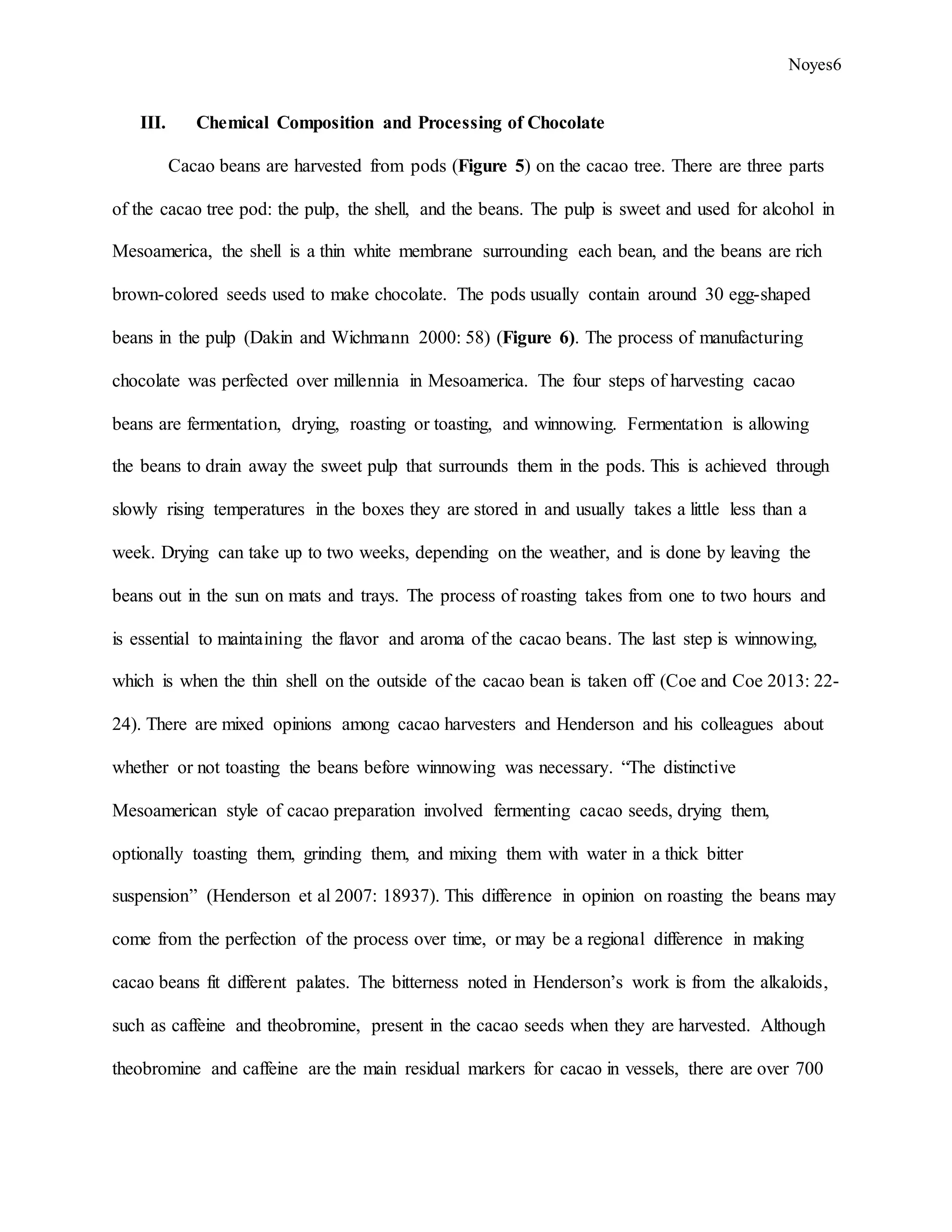
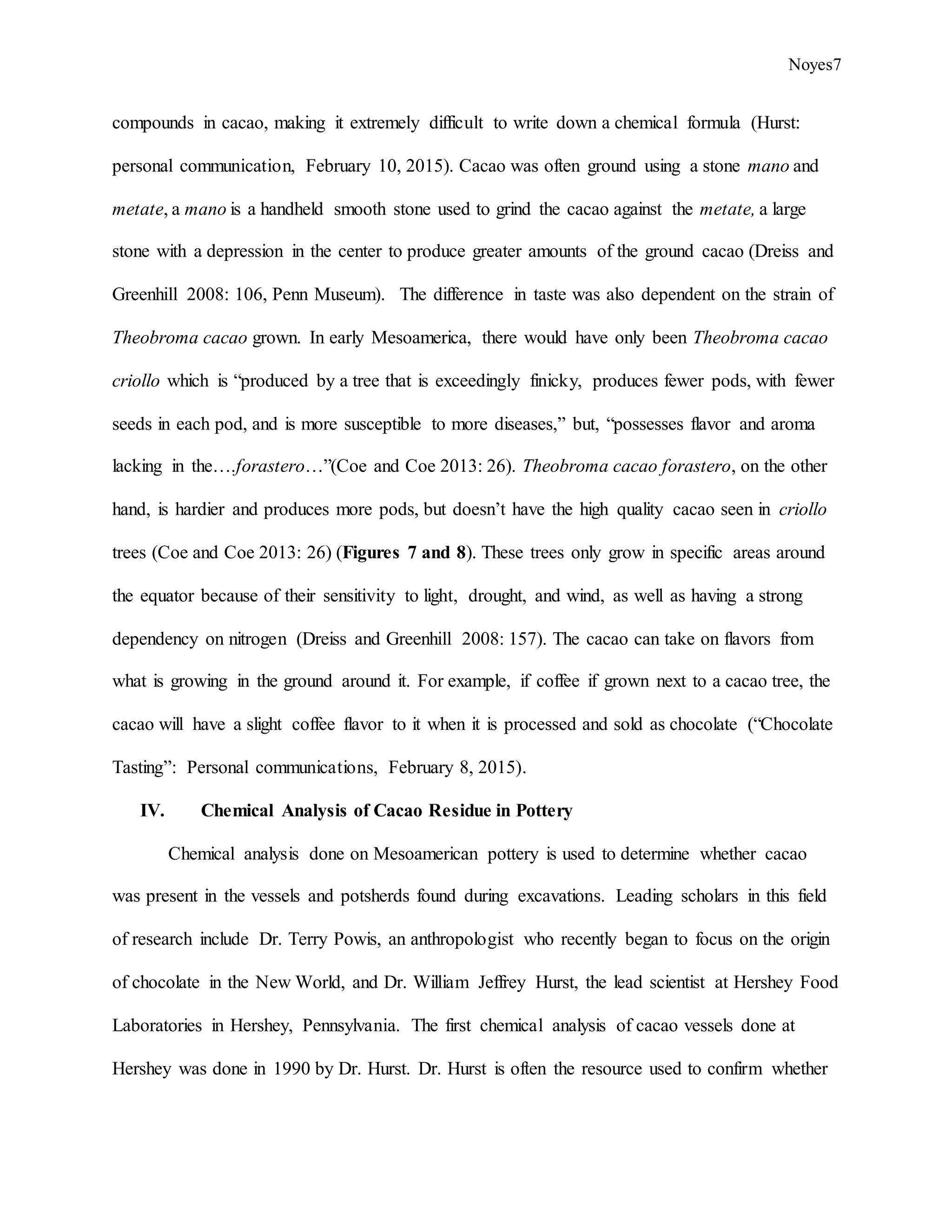

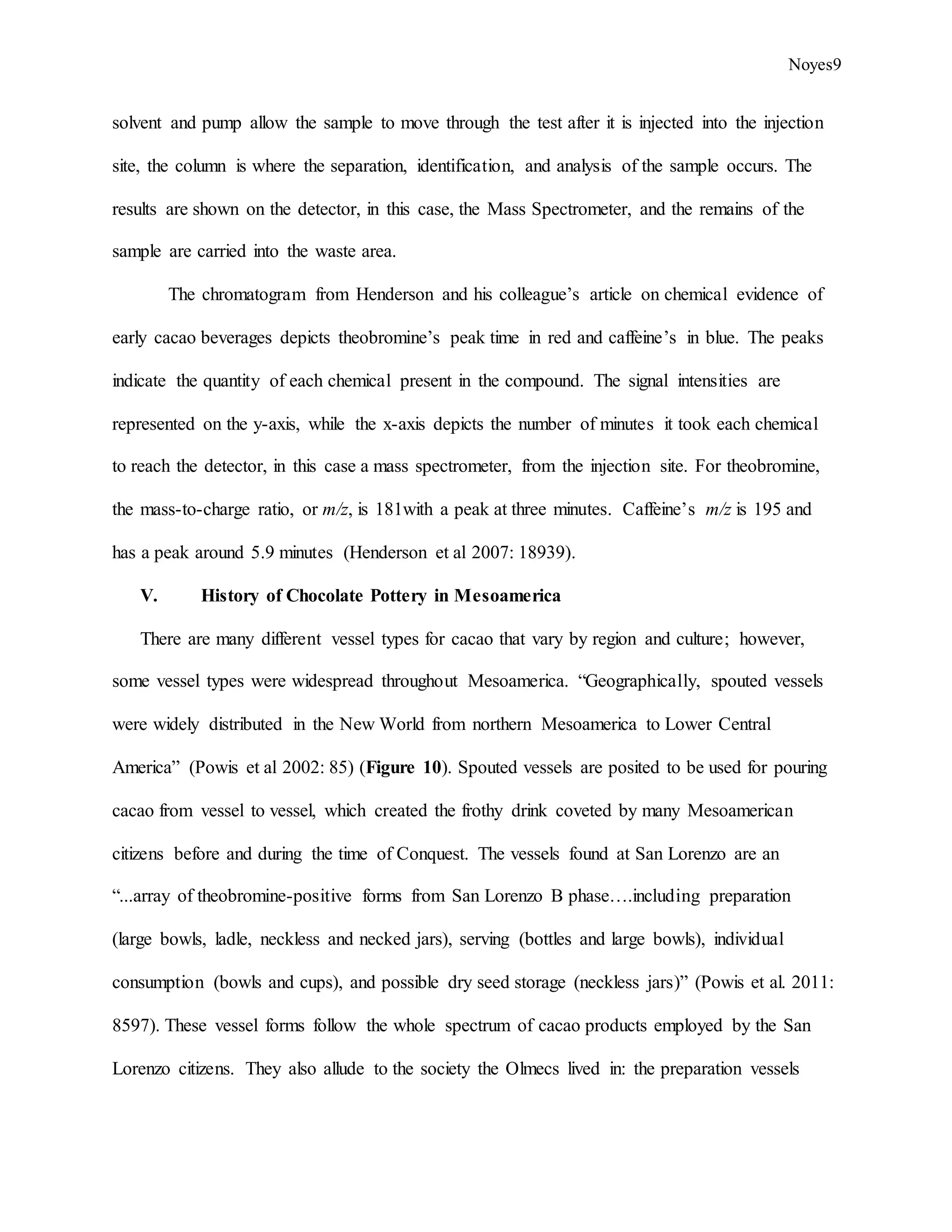
![Noyes10
indicate they manufactured their own cacao products, serving vessels indicate that they shared
the products they produced with other citizens of San Lorenzo; vessels for individual
consumption show that cacao was also important as a status marker among households and
families, and the potential storage vessels were used so that the beans could be stored for future
use instead of having to constantly wait for future harvests. Mesoamericans, including the Maya,
“incorporated [drinking chocolate] into rites used to codify the linear memories and histories of
some men and their associated houses, which marked them as distinct from those cyclical
memories of the larger group” (LeCount 2011: 348). Individual consumption and distinction
were important because the Maya and other Mesoamerican cultures emphasized remembering
each king and that the world was destroyed and recreated every so many years. It was important
to individuals to distinguish themselves among their equals and prove their superiority above the
lower classes.
Although the Classic Period ranges from 250CE until roughly 900CE, most Classic Maya
ceramics that are studied come from 500CE-800CE because there was an increased production of
ceramics throughout the Maya area (Grivetti 2009: 3). The Maya had over twenty vessel types,
but the most common vessel types for cacao beverages were cylindrical vases, tripod containers,
and spouted vessels (Helmke and Kettunen 2008: 20). Cylindrical vessels are called yuk’ib(ill) in
Mayan, which is the third person designation prefix ‘y’, with the verb, uk, (to drink) with ‘b’ as
the suffix. This label can be loosely translated as “his, her, or its drinking vessel” (Kettunen and
Helmke 2008: 20). In some cases, this can be seen on the vessels. On the 8th century vase from
Guatemala, we see a leader seated above his cacao drinking vessel, whereas other vessels depict
a ruler testing the heat of his cacao beverage before drinking it. However, during the Early
Classic Maya period, an anomaly was created. This vessel was from Río Azul, Petén, Guatemala](https://image.slidesharecdn.com/988f88ba-3106-47d8-8ab7-fa5c6282e09e-151208202925-lva1-app6892/75/Chocolate-Paper-2-25-Version-10-2048.jpg)
